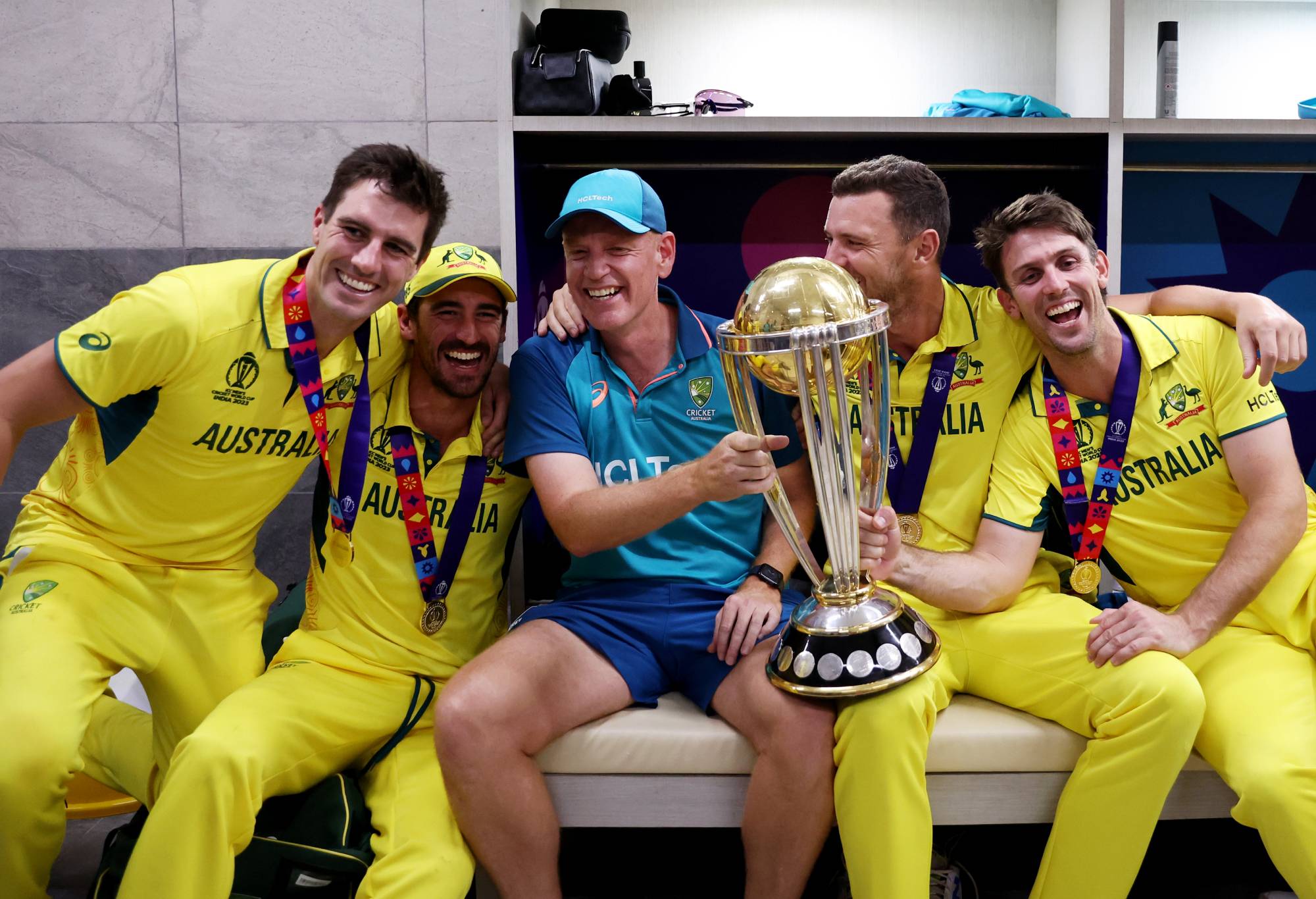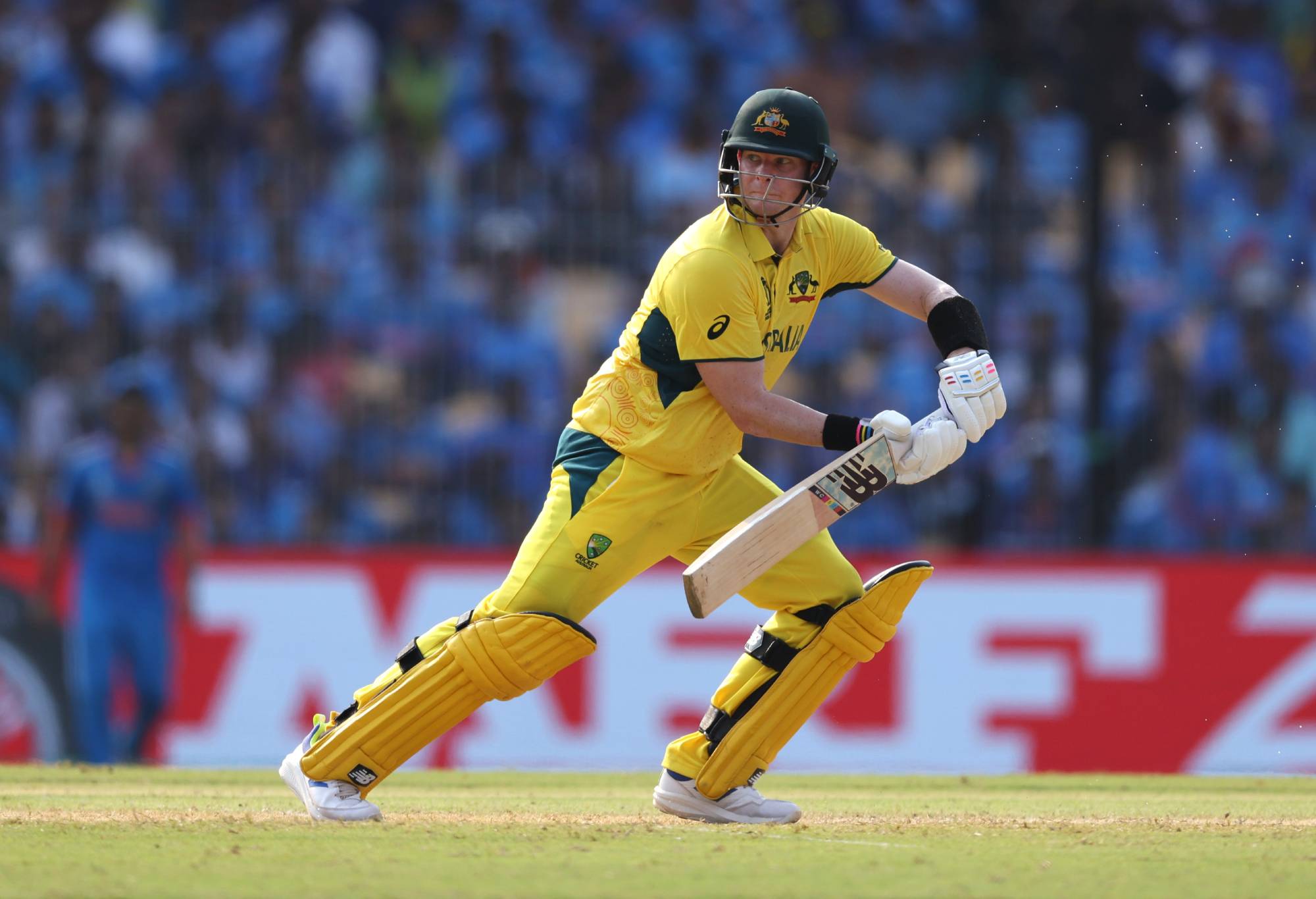Last summer when meagre crowds turned up to the meaningless bilateral series against England, alarm bells were ringing loudly for the beleaguered 50-over format.
Cricket Australia chief Nick Hockley described the forgettable three-match series which was staged just days after the T20 World Cup as “less than ideal”.
At the start of this summer, he was at it again saying that “it’s really important that there’s context for those bilateral series”.
And here we are, a couple of months later, about to take on the West Indies, a team that did not even qualify for the recent 10-team World Cup, in a three-match series.
Australia are fielding a weakened line-up while big guns Pat Cummins, Mitchell Marsh, Mitchell Starc, Glenn Maxwell (for various reasons) and Josh Hazlewood are rested.

Pat Cummins, Mitchell Starc, Josh Hazlewood, Mitch Marsh and Andrew McDonald at Narendra Modi Stadium. (Photo by Robert Cianflone/Getty Images)
To be fair, the current Future Tours Programme was negotiated 18 months ago but don’t expect these uninspiring white-ball series to fade from the schedule any time soon.
The Aussies are due to play Afghanistan, Ireland, England and Pakistan in bilateral white-ball contests in the months after the mid-year T20 World Cup.
Similar series are on the schedule next year in South Africa, New Zealand and India.
For 50-over cricket, the ICC is trying to revive interest in the format with the Champions Trophy which is due to be played in Pakistan early next year. Nobody was particularly concerned about this tournament before T20 was king and they certainly don’t care now.
With three world trophies flooding the schedule and the Olympics to be added to the mix from 2028 onwards, events like the Champions Trophy are just clogging up the already crowded calendar.
The ICC was on the right track leading into the last ODI World Cup by having a 13-team Super League fighting it out for 10 spots at the tournament in India.
That system meant that a team like the Netherlands could still come from the clouds and qualify ahead of traditional nations like the Windies and Zimbabwe, and when they made it to the showpiece event, they were not only battle hardened but able to be competitive against the top nations.
But of course the ICC brains trust in their infinite wisdom have scrapped that system for the 2027 World Cup in South Africa and Zimbabwe with the top eight teams in the rankings at a certain cut-off date early that year will get a spot along with the host nations with the rest having to advance via a qualification tournament.
So instead of a league table, cricket fans will have to keep an eye on the ICC world rankings to see who’s on their way to the Cup.
Cricket’s geography and limited number of strong nations makes it hard to replicate football’s gripping World Cup qualification process.
What about a system where the cut-off date is brought forward so it’s two years before the Cup and only a handful of teams, possibly the top six, get automatic entry to the tournament.
That way the remaining sides could be lined up for a series of qualifying clashes with the 12 highest-ranked sides then taking on each other for the remaining eight slots at the Cup in head-to-head showdowns or mini tournaments split into three groups of four.
It would give developing associate nations like Nepal, Namibia, Oman, the UAE and the US valuable competition against the higher-ranked sides and grow the format beyond its traditional borders, as has happened in the T20 version.
That would create plenty of interest and a whole lot of drama.

Steve Smith. (Photo by Matthew Lewis-ICC/ICC via Getty Images)
And it would help make ODIs relevant in between the World Cups.
Australia will begin their World Cup defence on Friday in front of more empty seats than fans at the MCG.
It’s not quite a changing of the guard just yet because Cummins, Marsh, Starc, Maxwell and Hazlewood will still play ODIs when they’re available.
Cummins, at 30, is probably the only member of that group who will probably still be lining up for 50-over matches at the next World Cup while Steve Smith, who will lead the team in his absence, is another who is almost certain not to go around for another full four-year cycle.
The new breed of Lance Morris, Matt Short, Aaron Hardie, Xavier Bartlett, Jake Fraser-McGurk and Will Sutherland, a late call-up for injured white-ball seamer Nathan Ellis, will each get their chance at various stages of the three-match series to show they belong at this level.
Jhye Richardson was the other player ruled out so he is also firmly in the selectors’ plans if he can ever string a season or two together without being sidelined by his various injuries.
Short and Hardie have had a brief taste of the international arena but the other four will be on debut – Morris has been in and around the Australian dressing room as a standby quick for more than a year so his first appearance is long overdue.
The Windies batters literally won’t know what’s hit them when he unleashes his thunderbolts.
Much has been critiqued and commented about Smith’s recent elevation to opener in the Test team and it would be the wrong move to follow suit with Warner’s vacancy in the ODI side.
Short and Fraser-McGurk should get a chance, perhaps even Josh Inglis as well, alongside Travis Head at the top of the order to see who could become Head’s regular partner long term.
Likely XI: Steve Smith (c), Travis Head (vc), Matt Short, Marnus Labuschagne, Cameron Green, Aaron Hardie, Josh Inglis, Sean Abbott, Xavier Bartlett, Adam Zampa, Lance Morris. Reserves: Jake Fraser-McGurk, Will Sutherland.






























































































